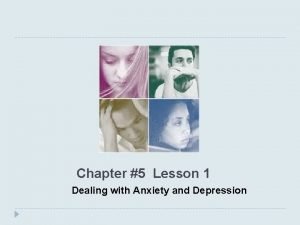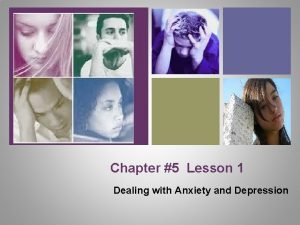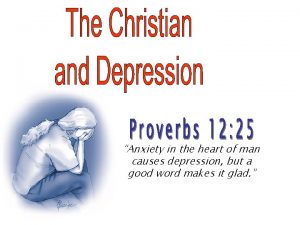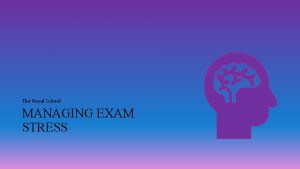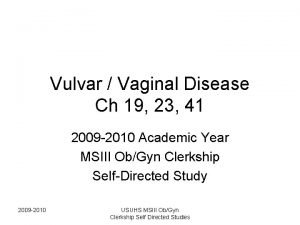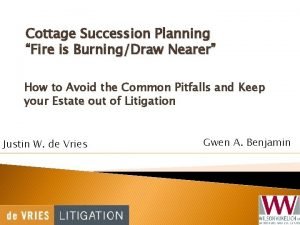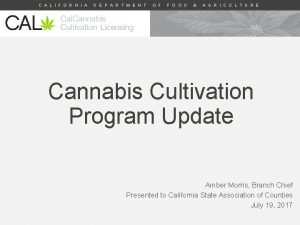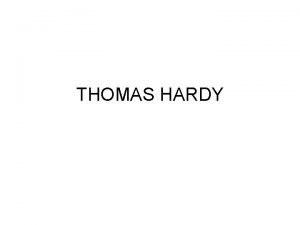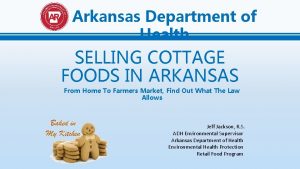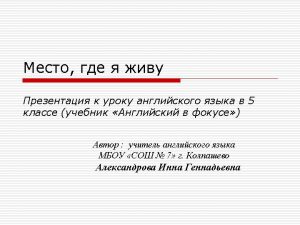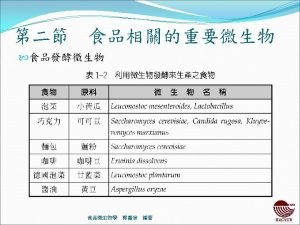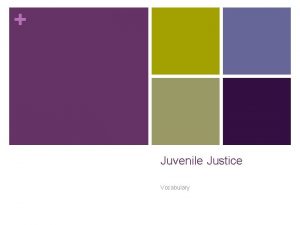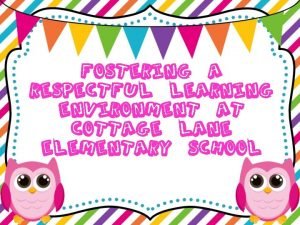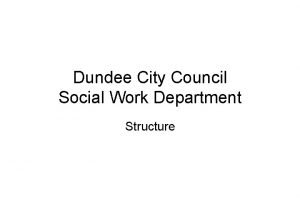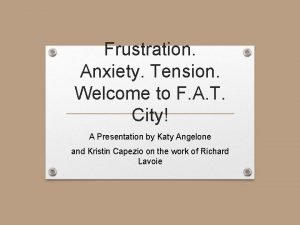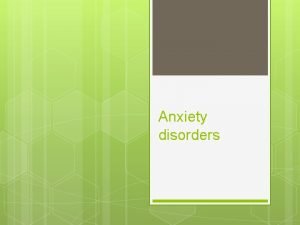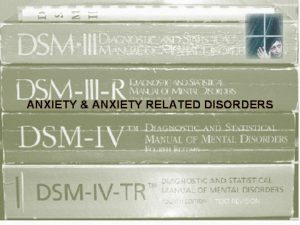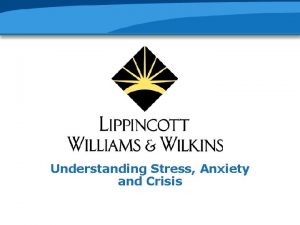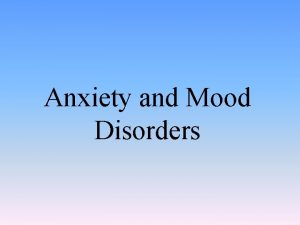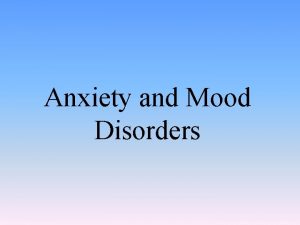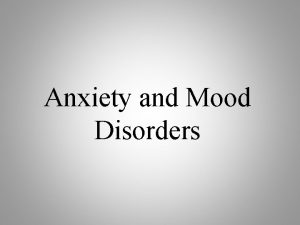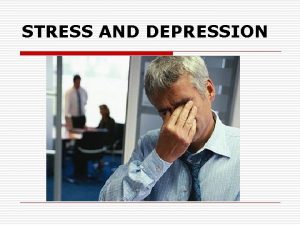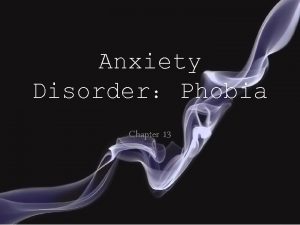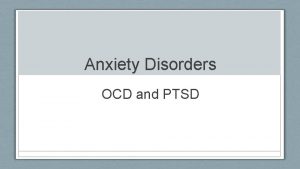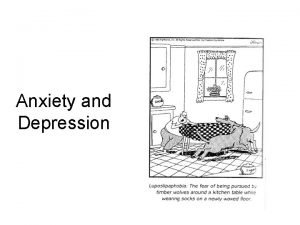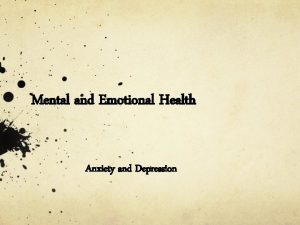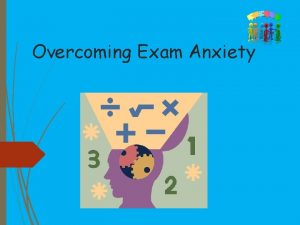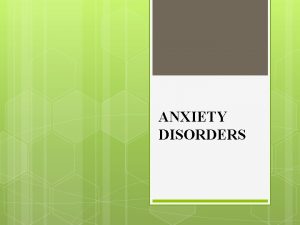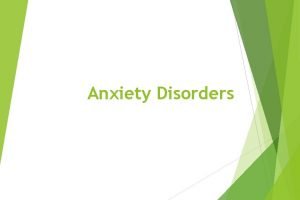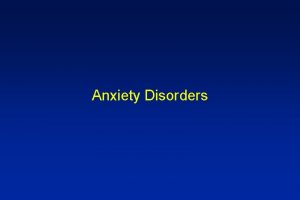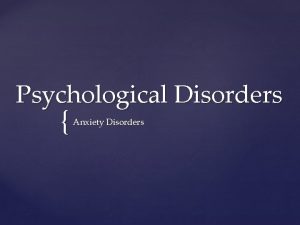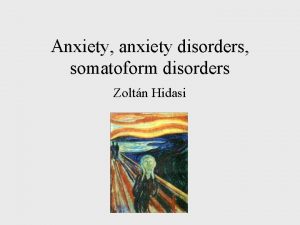Stress Anxiety and Depression Presentation for Youthnet Cottage















































- Slides: 47

Stress, Anxiety and Depression Presentation for Youthnet, Cottage Boardroom, Nov 16, 2005 Michael Cheng, Psychiatrist http: //www. drcheng. ca

This presentation is protected under a Creative Commons Deed (http: //creativecommons. org/licenses /by-nc-sa/2. 0/ v You are free to copy, distribute, display and perform this work, as long as this work is not used for commercial purposes v

Goals An overview about stress, anxiety and depression in youth v What is it v What causes it v What can you do about it v Where to get help (in Ottawa) v

Top Questions from Youthnet Facilitators What is the meaning of life? v What is bipolar? v Common causes of teenage depression? v What to do when having an anxiety attack? v Where to refer someone with mood/anxiety problems (in Ottawa)? v

It’s All About Balance

Q. What do normal people need in life?

Everyone needs a healthy body, mind, spirit 1. 2. 3. Body (Physical, Biological Self) Mind (Psychological, Emotional Self) Spirit (Spiritual Self) Note: Overlap, e. g. psychological interventions can cause biological changes, and vice versa Mind Body Spirit

The Triple A Agency / Autonomy / Achievement Activity (as opposed to passivity) Affiliation (Relationships)

The Triple C Control “Chipper” (or being active) Connections with Others

Three P’s Power Proactive People

Point A Point B (Goals)

Obstacles such as stress (at home, school, work), depression, anxiety Point A Point B (Goals)

Life is full of things that cause imbalance (in mind, body, spirit)

Typical stresses in our modern society v Body – Medical / physical illness – Lack of sunlight / Drug Use v Mind / Social – – – v School / Work Classmates / co-workers Family Friends Boyfriends/girlfriends Spirit

Life is a balance between coping and stress Coping Ability Demands / Expectations / Stresses

Problems if demands, expectations or stresses outweigh coping Coping Ability Demands / Expectations / Stresses

There are two solutions to restore the balance. . . Coping Ability Demands / Expectations / Stresses

Stress can lead to: Physical problems v Emotional or mood problems such as v – – – Depression Anxiety Eating Disorders OCD Any problems with mood/coping. . .

Prevalence of Mental Disorders in Children and Adolescents in Canada (Stats Can, 2002, age 0 -19) Anxiety Disorder 6. 5% ADHD 3. 3% Depressive Disorder 2. 1% Substance Abuse 0. 8% Schizophrenia 0. 1% Bipolar Disorder 0. 1% Eating Disorder 0. 1% Etc. . . ANY DISORDER 15%

Mood Disorders: What is It? Everyone gets sad from time to time v Just enough sadness is good because it alerts people to do something to change their situation v Mood disorders are when people’s moods are so extreme that it gets in the way of life v It is not normal, and is not something that someone can easily ‘snap out of’ v

Mood Disorders: To Diagnosis or Not to Diagnosis? v v Classified according to the DSM-IV For formal DSM-IV criteria for disorders, visit www. mentalhealth. com Although imperfect, the DSM-IV nonetheless reflects an improvement from the past, when there was no common language in talking about what was, or was not a mental condition Each version of the DSM gives us a greater understanding of mental conditions

Mood Disorders: To Diagnosis or Not to Diagnosis? v Pros – Gives us a common language – Allows people to learn and get support about their condition or problems v Cons – Being ‘labelled’ may carry a stigma (perhaps stigma is the true problem? ) – The fact that people may misuse a diagnosis to avoid responsibility for a problem – Being put into a box

My personal bias. . . v Appropriate use of a ‘diagnosis’ in the right situation can be helpful

Example of How To Use a Diagnosis v v v “You’ve told me that before having these problems with your mood, you were always a happy, high achieving, outgoing person. ” “You’ve mentioned having problems with your mood, sleep, appetite, concentration and energy, and that you’ve been feeling hopeless. ” It sounds like you may have a medical condition called depression. The good news is that this condition is very treatable and we can help you feel better again. ”

Example of How To Use a Diagnosis (Cont’d) “You are not responsible for causing this condition. ” v “However, it is mainly up to you to get better. ” v “But the good news is that you are not alone – we will support you in overcoming the depression. ” v

Mood Disorders: Types Major Depression (aka Clinical Depression, Major Depressive Episode) v Dysthymic Disorder (aka low grade depression) v Adjustment Disorder (mood problems following a stress, but not severe enough to be major depression v Bipolar Disorder v

Major Depression Problems with mood (sad, angry, irritable), PLUS v Physical problems with v – Sleep, Energy, Appetite, Concentration v May also have problems with – Thoughts • Low self-esteem • Hopelessness / Suicidal thoughts – Behaviors • Social withdrawal, loss of function

Dysthymic Disorder Problems with mood (sad, angry, irritable), PLUS v Some physical problems v Some problems with v – Thoughts – Behaviors v BUT is not as severe as Major Depression

Adjustment Disorder Problems with mood (which are not severe enough to meet for depression or dysthymic disorder) following a stress v Does not involve significant changes v

Bipolar Disorder v v A condition with severe highs and lows where one’s moods are like a roller coaster, to the point it causes problems During highs – Mood high or irritable, excessive energy, less need for sleep, excess talking, excess activities v During lows – No energy, depressed mood, more need to sleep, i. e. essentially like being depressed

Anxiety Disorders Everybody has worries and gets anxious from time to time v Just enough anxiety is helpful because it keeps us cautious and safe v Anxiety Disorders are when one has so many worries that they get in the way of life v

Types of Anxiety Disorders (or Conditions) v Generalized Anxiety Disorder – Constant worries with physical symptoms that cause problems v Panic Disorder – Out of the blue feelings of panic that cause problems v Obsessive Compulsive Disorder – Repetitive thoughts or behaviors that cause problems v Social Anxiety Disorder – Extreme shyness that causes problems

Restoring the Balance

A General Approach to Helping Others v Figure out the person’s goals – “What would you like to get from coming here to see me/us? ” v Figure out what to do to get to that goal – “What do you think we need to do to get to your goal? ”

A General Approach to Helping Others v Figure out what stress is causing (or contributing to) the anxiety or depression – Usual stresses include • School • Family • Friends v Problem-solve and find ways to deal with that stress

Approach to Conflicts Conflict is when two parties want or expect different things v Solution v – Figure out what each party wants or expects from the other – Ensure it is reasonable – For things that each party wants in common, great! – For things that each party disagrees on, negotiate and compromise

Everyone needs a healthy body, mind, spirit 1. 2. 3. Body (Physical, Biological Self) Mind (Psychological, Emotional Self) Spirit (Spiritual Self) Note: Overlap, e. g. psychological interventions can cause biological changes, and vice versa Mind Body Spirit

Body v Ensure healthy amounts of – Sleep – Diet/nutrition – Exercise • Individual exercise • Group / social exercise • Yoga / Martial Arts – Sunlight (in the case of winter depression)

Body Medications may be a helpful ‘body’ or physical intervention in certain circumstances v For anxiety and depression, in general v – Non-medication strategies are tried first – Medications are used if non-medication strategies are unsuccessful

Body v Common types of ‘self-medication’ – Sweets, carbohydrates, chocolates • May possibly be a way of getting serotonin – Exercise • May be a way of getting adrenaline / dopamine – Caffeine • May be a way of getting adrenaline / dopamine – Street drugs

Mind v Ensure good coping strategies and ways to deal with stress – – School / work Family Friends and Boyfriends/girlfriends

Mind v Psychotherapy such as cognitive behavior therapy – Anxiety or depression is caused by cognitive distortions – Fixing cognitive distortions will overcome the anxiety or depression

Thoughts

Spirit Figure out what gives meaning to the person’s life v Ensure those things are in the person’s life v

Types of Help for Anxiety and Depression Speaking with friends v Speaking with family v Speaking with religious supports (e. g. chaplain, priest, rabbi, iman, etc. ) v

Types of Professional Help for Anxiety and Depression School personnel (teachers, guidance counselors, vice-principal, social workers, coach, etc. ) v Medical Doctors (family physicians, pediatricians, psychiatrist) v Psychologists v Counselors v Social Workers v

Questions?
 Stress anxiety depression
Stress anxiety depression Chapter 5 lesson 1 dealing with anxiety and depression
Chapter 5 lesson 1 dealing with anxiety and depression Chapter 5 lesson 1 dealing with anxiety and depression
Chapter 5 lesson 1 dealing with anxiety and depression Anxiety in the heart of man causes depression
Anxiety in the heart of man causes depression Chapter 8 managing stress and anxiety
Chapter 8 managing stress and anxiety Anxiety symptoms
Anxiety symptoms True fracture strain
True fracture strain Chapter 10 stress responses and stress management
Chapter 10 stress responses and stress management Normal axial stress
Normal axial stress Micro cottage and small industry promotion center
Micro cottage and small industry promotion center Yellow cottage cheese discharge
Yellow cottage cheese discharge Definition of secondary sector
Definition of secondary sector Nick carraway cottage
Nick carraway cottage Matilda miss honey cottage
Matilda miss honey cottage White cottage cheese discharge
White cottage cheese discharge Cottage succession planning
Cottage succession planning Characteristics of cottage industries
Characteristics of cottage industries Specialty cottage indoor license
Specialty cottage indoor license Taekwondo pattern meanings
Taekwondo pattern meanings Cottage chamonix
Cottage chamonix Doc hardy's cottage
Doc hardy's cottage John kay inventor
John kay inventor A cottage in the lane poem
A cottage in the lane poem Cottage law los angeles
Cottage law los angeles Cottage law arkansas
Cottage law arkansas Masuso cottage 11 scandal
Masuso cottage 11 scandal Flat house cottage sofa
Flat house cottage sofa Ohio department of agriculture food safety
Ohio department of agriculture food safety Cottage
Cottage Juvenile delinquency vocabulary words
Juvenile delinquency vocabulary words Jethro tull invention
Jethro tull invention Cottage lane elementary school
Cottage lane elementary school Charyot korean
Charyot korean The poorest man may in his cottage
The poorest man may in his cottage Northala cottage
Northala cottage Dilcec dundee
Dilcec dundee Frustration anxiety and tension
Frustration anxiety and tension Chapter 15 anxiety and obsessive-compulsive disorders
Chapter 15 anxiety and obsessive-compulsive disorders What is rational detachment
What is rational detachment Vertex presentation and cephalic presentation
Vertex presentation and cephalic presentation Leopold maneuver
Leopold maneuver Formuö
Formuö Novell typiska drag
Novell typiska drag Nationell inriktning för artificiell intelligens
Nationell inriktning för artificiell intelligens Ekologiskt fotavtryck
Ekologiskt fotavtryck Varför kallas perioden 1918-1939 för mellankrigstiden
Varför kallas perioden 1918-1939 för mellankrigstiden En lathund för arbete med kontinuitetshantering
En lathund för arbete med kontinuitetshantering Särskild löneskatt för pensionskostnader
Särskild löneskatt för pensionskostnader

